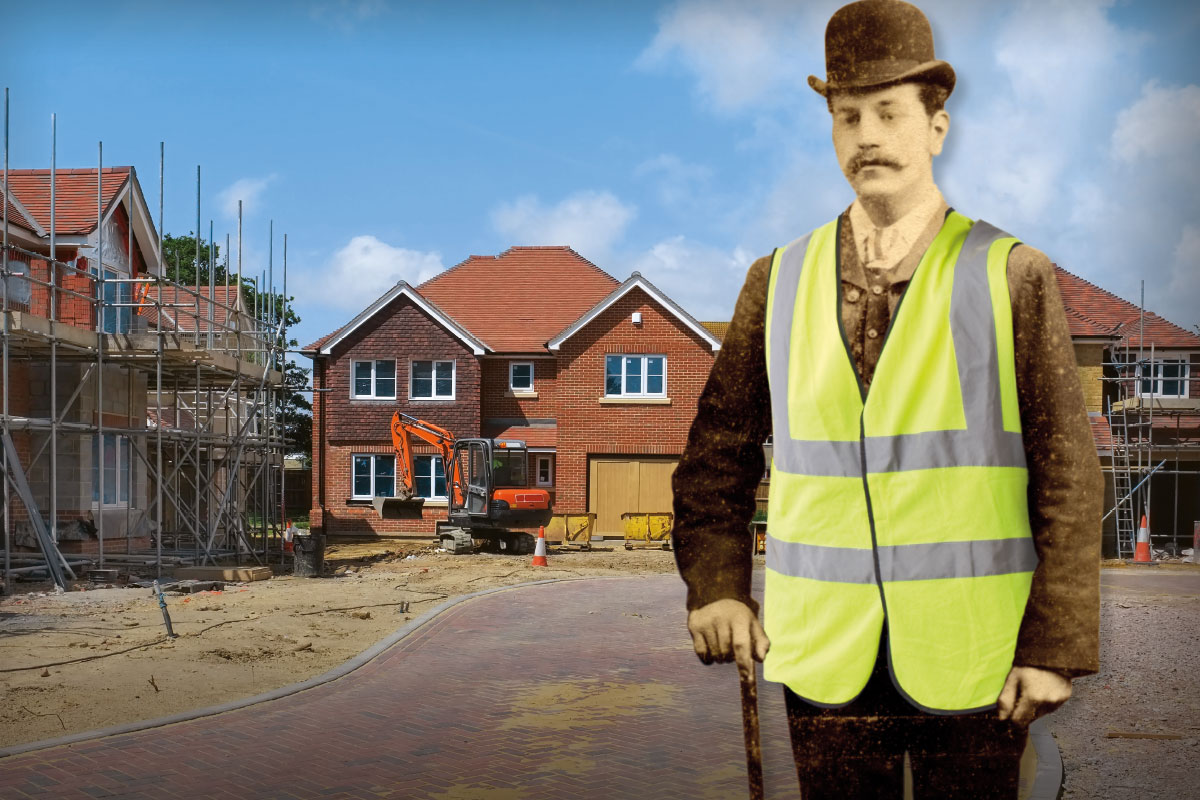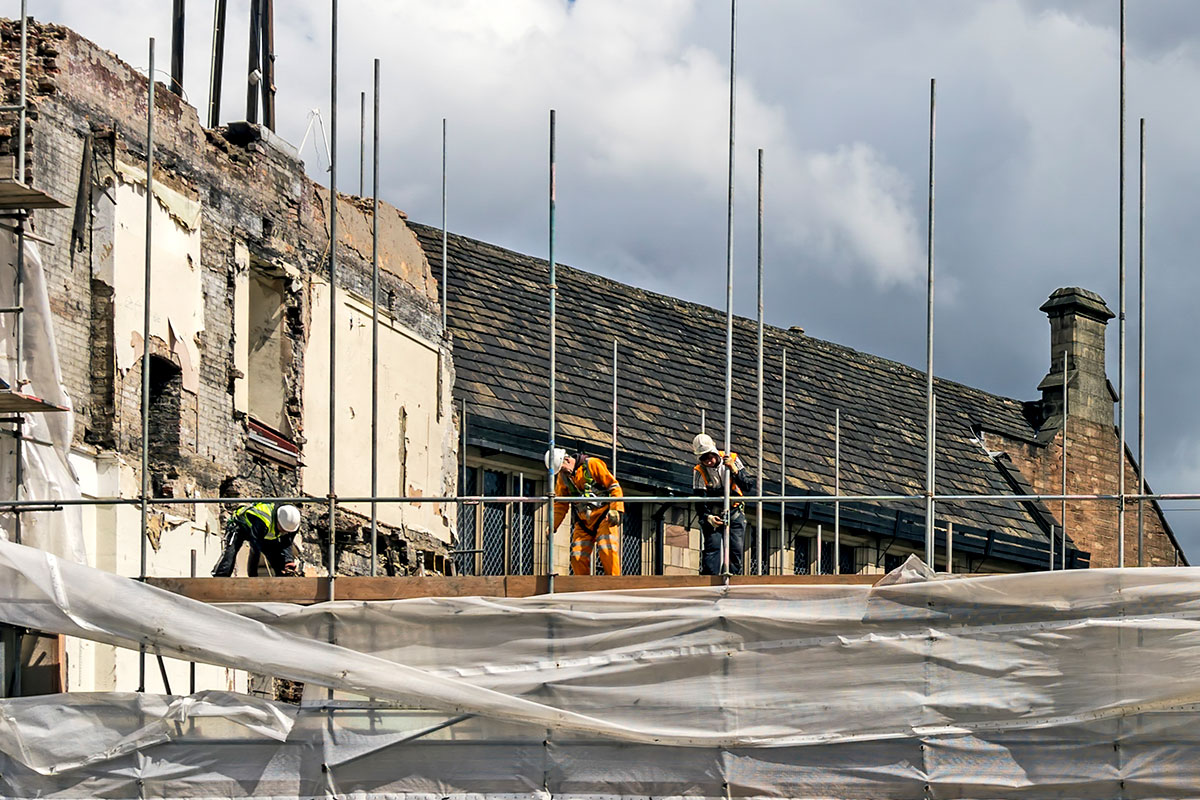You are viewing 1 of your 1 free articles
Would a large-scale return to clerks of works improve building safety?
Following Grenfell, the Royal Institute of British Architects warned government that the disappearance of on-site clerks of works was a big problem. Does the role need to be reintroduced on a much bigger scale? Tim Clark reports. Pictures by Getty
Brendan Hunt, senior clerk of works at MDA Consulting, is considering the hole that has appeared in the corner of what should be someone’s future flat.
“Someone hasn’t realised that these flats are different to the others [in the block] and didn’t think about where this ducting is going to go,” he says. MDA Consulting is inspecting the site to ensure that it meets the quality expected in new residential developments.
If not addressed during the building process, this kind of issue usually ends up as a complaint for a housing officer. “The client won’t be happy,” Mr Hunt adds. “And someone is going to have a slightly smaller living room.”
We’re 14 storeys up on the site of a new residential tower in west London, and Mr Hunt is inspecting site progress while telling Inside Housing about the finer points of moving ventilation ducts – an issue that should have been picked up during the design stage (the identity of the site is being kept secret as a condition of allowing us to tag along).
The hole, among a number of other minor issues that crop up during our hour-long tour, is known in the trade as a ‘snag’.
Although the role of the clerk of works was considered among the most prominent professions on any construction site since the days of Chaucer, it has been in decline for the past few decades.
According to Andy Benzies, clerk of works at Peabody, the shift from clerks to site managers has had a stark impact on the construction sector. “When I worked for Kent Council we had 40 people in our clerk of works team in the late 1980s. In five years it went down to three, it went off the wall, and that happened in pretty much every local authority in the UK.”
"The role of the clerk of works was considered among the most prominent professions on any construction site since the days of Chaucer"
Two major incidents, however, have challenged the perception that the role of the clerk is obsolete.
In January 2016, nine tons of masonry were blown off the side of Oxgangs Primary School in Edinburgh when part of the outer wall collapsed in high winds.
The investigation into the Oxgangs incident, led by architect John Cole, found that poor workmanship and lack of work-site supervision lay behind the incident. Mr Cole’s report recommended that either a clerk of works or a resident architect be present on sites. The Scottish Parliament’s Education and Skills Committee has since backed Mr Cole’s findings.
Just over a year after Oxgangs, the tragedy at Grenfell Tower unfolded, killing 72 people. Following the fire, the Royal Institute of British Architects warned government that the virtual disappearance of on-site clerks of works in undertaking detailed continuous inspection of the work of contractors had “led to a great diminution in the level and effectiveness of independent oversight of construction and workmanship”.
Quality issues are not limited to only these two examples. A study by housing charity Shelter in 2017 found that more than half of all new build homes had suffered from major faults.
Of the 4,300 homeowners questioned for the study, 51% reported issues with unfinished fittings and faults with utilities.
Mr Benzies says that quality has been compromised. “The problem is that site managers [who replaced clerks] are either an agency manager who don’t give a monkey’s about quality, or site-based managers who work with the contractor and tend to be under qualified,” he says. “They don’t look at quality issues as they are under pressure to get the project done.”
According to Nick Gornall, head of development at 19,000-home Great Places, changes to construction contracts have had an impact on quality – for example, a move to design and build has seen contractors leading on the design and management of a construction site, including often inspecting the quality of the build internally.
“We have to think afresh post-Grenfell, in light of the Hackitt report.” - John Healey, shadow secretary of state for housing
Design and build is a type of contract where a single entity is commissioned to do the whole project, rather than commissioning an architect and then later putting out the construction to tender.
“The management structure of construction is fragmented,” says Mr Gornall. “You have subcontractors and sub-subcontractors, so there is no direct link to those who drive quality. That has broken the trust bond, in my opinion.
“Senior management at construction companies have been surprised by how much people have been getting away with. Now the pendulum has swung back the other way.”
From a gantry overlooking the floor of the west London housing project with Mr Hunt, we watch a group of workers dressed in their personal protection equipment getting their morning work briefing.
Their job is to piece together balconies before they are hoisted up and fixed to the walls of the tower. Mr Hunt points to a series of black panels where the balconies, door frames and exterior envelope will fit together. “That’s the fire break there. That, in event of a fire, will expand and stop the fire spreading up the building,” he explains
Brendan Hunt, senior clerk of works at MDA Consulting, on site in London
Mr Hunt, who spent seven years working for Transport for London as an inspector during the Jubilee Line extension, tells me that Grenfell has made a difference – especially when it comes to clients’ demands on site.
“Clients are very hot on the fire safety element at the moment, as are some contractors,” he says.
“I know one large contractor that has employed a clerk recently to pick up on snags in work before it is passed over to me, to make sure they get better quality.”
One pivotal aspect of the clerk of works is their independence from the construction process.
The clerk is often employed by the client, rather than the contractor, to check the quality of the construction.
Rachel Morris, chief executive of the Institute of Clerks of Works and Construction Inspectorate (ICWCI), says: “The inspections help to protect the clients’ interests throughout the construction process.”
However, traditionally a clerk can only report issues, not instruct contractors to make changes. Those decisions are left to the clients or their agents.
"One pivotal aspect of the clerk of works is their independence from the construction process"
According to Steve Slater, clerk of works at Great Places, which employs four clerks to manage both its development programme and its property portfolio, experience in the construction trade is key. “I know what people have tried to get away with and I look for things like that,” he says. “When I enter a site… I understand what the men are like and the attitudes are like on site. You have to build up that communication, and get away from the idea that I am an adversary. I am there to be leaned on – use my knowledge to help and then become an asset to the project.”
For Mr Hunt, one of the core aims is to gain trust with clients and contractors and begin the process of bringing standards up.
“Some clerks come in and have the wrong attitude. They’re abrasive; they rub people up the wrong way. I work with the contractors; that way they come around sites with me and things get fixed – they don’t run off when I turn up on site.”
It is a far cry from the 1980s image of the clerk, presiding over sites as an authority figure.
Mike Brooks, associate director at MDA Consulting, says that clients had begun taking more interest in clerks since the start of the decade. “They have realised that there needs to be a second pair of eyes on jobs,” he says.
“Years ago, the clerk was an adversarial role. He was seen as the spy in the camp. Now contractors often work with us, there is more collaboration and there is an appreciation of having that presence on site.”
Observing Mr Hunt as he makes his way down the levels of the half-built tower is akin to watching a buyer checking out prospective flats.
Mr Hunt breezes in and out of rooms as if he is sizing up furnishings, however behind the apparent laissez-faire attitude is 50 years of experience in the trade.
Closing up – which is when work that might need to be checked can’t be accessed because of progress on site – is also an issue. On large construction sites, the volume of work can mean that ad hoc inspections do not see every detail of the construction work.
The local authority’s building control team is tasked with inspecting sites at set stages, and the National House Building Council sends inspectors more regularly, but for continuity, a weekly or daily inspection by a clerk is often the only occasion when builds are checked regularly.
We ask Mr Hunt how he identifies issues on sites. He has trouble putting his finger on it. “It’s difficult to explain what to say you’re looking for,” he says. “You just keep an eye on everything as you go and before they close things up.”
Of course, clerks are not infallible. In 1834, Richard Weobley, the clerk of works for the Houses of Parliament, chose to burn two carts’ worth of tally sticks – wooden sticks used to record receipts for government income – in an oven in the basement of the palace. The resulting fire almost destroyed the entire Houses of Parliament.
Speaking to Inside Housing in the Churchill Room of the rebuilt 19th century Parliament, John Healey, shadow secretary of state for housing, says that the clerk alone cannot bring standards up to scratch.
“I think we have to think afresh post-Grenfell, in light of the Hackitt report, rather than casting back 50 years for a system that might have been in place then. Things have moved on now to such a degree,” he argues. “If you look at Lakanal House, Shirley Towers or Grenfell, this indicates a systematic failure of standard-setting, control, inspection, sign-off – all of which has to be overhauled. Simply coming up with one person who can fix a broken system is too simple.”
Mr Healey may have a point. However according to Mr Hunt, the role of the clerk to simply check quality cannot easily be replaced. “How many jobs have gone wrong that we don’t know about because it [the building] hasn’t failed yet?” he questions.
A key issue is where the next generation of clerks is going to come from.
MDA has appointed one new clerk, a female carpenter who joined after working on sites for a number of years, who brings its total clerk workforce to seven. Mr Benzies says that Peabody is looking to expand its nine-strong clerks team to 13 or 14 to cope with the development programme, and has recently taken on an apprentice. Demand, however, is there in the market.
Mr Benzies says: “I am being headhunted every single week – in the past two years I was getting eight to 15 calls a week asking about roles.
People are playing catch-up, and not just the housing associations. You have Berkeley Homes and Barratt re-evaluating the roles.”
The ICWCI is working as part of the Construction Industry Council to urge government to consider adding a bespoke clerk of works qualification to the approved list of apprenticeships. However, the task is proving difficult and the process to get any apprenticeship approved is lengthy. The answer may be collaborating with other professions and enticing those in construction to consider a clerks role rather than retire.
After the inspection is complete, Mr Hunt admits over coffee that he himself is working past retirement age. “We need more clerks, but where are they going to come from? They don’t grow on trees,” he says.
Mr Brooks of MDA says that until the next generation of clerks are trained, we will see more clerks coming from the tail end of careers on sites. “A lot of our guys are quite mature and several are past retirement age but have a lifetime of experience,” he says. “The clerk role is manageable; as long as you are physically fit you could work past 70, but anyone working on sites would struggle at that age.”















